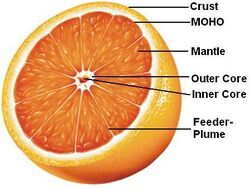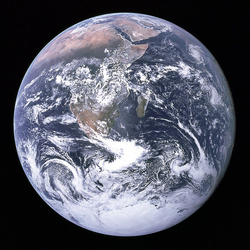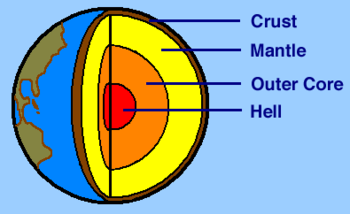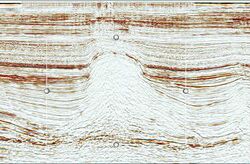Earth Structure
The Earth is not just a large monolith floating about aimlessly in space, it is also a complex yet structured lump of rock derived from a meteor impact which hit the Moon 3.6 billion years ago. As the Earth orbited the Sun, it gradually collected the residual remants of the Moon (now much smaller as a result) over several millennia which coalesced to form molten rock and finally enter the solidus state after being subjected to over 65 Pa of pressure from the surrounding atmospheric gases. The interior structure of the Earth is layered in spherical shells, akin to the categories of articles within the satirical news website The Onion.
Previous Models[edit]
The Steve Guttenberg model which was modified in 1976 set out the first detailed cross-section of the Earth which brought together the components known as the Crust, Mantle and Core. It claimed that the Earth was a giant ball of molten magma which was held together by a solid crust. It also inferred that there was a large core of iron (Ag) stuck somewhere in the middle that produces the Earth's magnetic field and helps stop the planet floating away. Planet Earth is also the densest planet in the Solar System of due to a net density of 5515 kg/m3 and a large country called the USA bringing the average IQ level down to 78.3.
Previous models were highly inaccurate, including an exploration well which punctured into the ceiling of a cave which led scientists in the 1920s to believe that the planet was hollow below 340m. Jules Verne's model, as postulated in his farcical scientific inquiry 'Journey to the Center of the Earth', purported a hollow core inhabited by prehistoric organisms, however this theory has been largely discredited by 'common sense' and numerous thought experiments involving Verne's immolation. Before that, the church believed that the earth was flat and that if you went deep enough then you would puncture back into space until the breakthrough discovery when Christopher Columbus sailed around the world and ended back up in the same place he started.
New Model[edit]
After the increase of oil exploration in the late 20th and early 21st Century, several oil wells successfully broke through into the inner regions of the Earth beyond 35km to reveal hard evidence of what composes the planet underground. At first New Scientist magazine announced that it was composed of mature cheddar cheese until a driller engineer finally admitted that he dropped a piece of his sandwich down the borehole by mistake. The Saddam Hussein Memorial Model drawn up in 2007 was remarkably similar to the previous Gutenberg model with a Core, Mantle and Crust but with more structural complexity.
Crustal Geology[edit]
This is the part that you're currently standing on, unless you're in a South African diamond mine in which case you would be within the Upper Mantle just below the Moho (Malkovich discontinuity). The crust is composed mainly of pumice due to volcanic events and as a result floats upon the Upper Mantle giving rise to Continental Drift. Up to 132 miles thick in places and as thin as 0m within the East African Rift, the crust contains all natural resources used by man today, including Gold, uranium, coal and cocaine in it's natural ore form.
The crust exists because the Mantle is a molten body which cools rapidly when in contact with subzero space. This creates a seal which stops both the mantle and migrating oil leaking out all over the place. Occasionally an earthquake may occur which cracks this seal and gallons of red hot lava may leak everywhere until it slowly flows back into the ground from which it originated. In a subduction zone however, it may come back up again and blow up rather violently however where water can filter down as far as the Core which will allow it to boil. This boiling effect then hydrates the mantle magmas which may then create a lethal mixture of small chain polymerised silicates which allows these explosive events. Lava from an Earth-born volcano was discovered on the first Moon mission and demonstrates the fierocity of such such events.
Mantle Geology[edit]
As shown in the diagram above, the Mantle is an eleven-piece segmented body acting as separate compartments bounded by feeder plumes. These plumes are lines of weakness within the mid-Earth and allow parts of the Outer Core to filter up to the Crust and create evenly spaced volcanic island chains on the sea-floor (see Core Geology section below). The eleven compartments filled with molten magma are known as magma chambers which feeds the crust with molten fluids. Midway through the cycle, this magma may become lava should the fluids react with Ni/Fe -bearing Core-fluids rising from deeper towards the centre of the Earth.
The Segmentation also splits convection up into eleven different constantly moving mantle currents. This in turn drives the Continental Drift affecting the Crust with the eleven currents splitting the earth's surface into about a dozen plates (almost one plate per segment - the extra one stores 97% of the world's magma supply). Seismic interpretation infers that the Mantle is layered, indicating possible dense hydrocarbon volumes sinking to the base of the compartments and separating into viscous layers. These are thought to become the main hydrocarbon targets when crustal resources are exhumed on the 3rd of February, 2013.
Core Geology[edit]
Exposed only within a section of the East African Rift, the Mantle is a large body of Iron Pyrite with the pyrite part being a bit of a surprise to geologists who were expecting something a little more interesting. Seismic data however shows a layered appearance towards the core-centre implying the presence of a chemical boundary, thus producing an Inner Core and an Outer Core. The seismic quite clearly shows the presence of onlaping lagoonal reef-carbonates (limestones/dolomites) bounded by a sequence of algal mudstones within the Inner Core, leading to the Sedimentologist's Theory that the Earth has been growing layer by layer over the last 3 or 4 billion years, constantly compacting sediments derived from Core structural highs.
The Outer Core however is much lighter and has been slowly protruding up into the Inner Mantle which results in igneous activity and volcanism at the Earth's surface. Often this upwelling results from the formation of Rifts where the Crust is splitting due to constant strain from an ever growing core. The rotating core also causes such upwelling to occur in a screwdriver like fashion which sometimes (in rare cases) can almost reach the surface. Such near-surface activity may initiate what is known as a hotspot and produce island chains, the British Isles providing an excellent case study of such volcanic islands.
See also[edit]
References[edit]
- Brown, T.P., McDonald, K. 2001. Centre of the Earth. Lonely planet traveller's guide.
- Buck, H.G., Stephenson, A. 1993. New perspectives on the composition of the inner mantle: red leicester or gorgonzola? Geological Society, London. Vol 34, pp 134-146.
- Gutenberg, S. 1976. Compartmentalisation within a convective inner mantle, a layered iron core and a cherry on top. New York Free Press, pp 3-4




